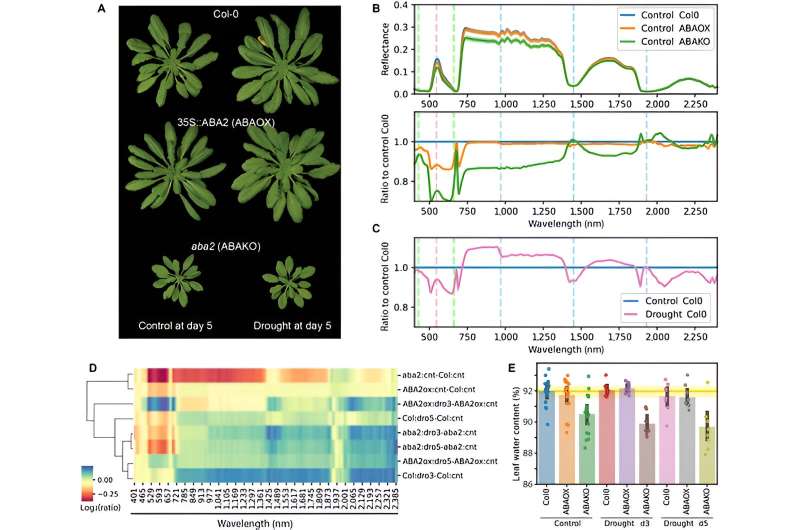This article has been reviewed according to Science X's editorial process and policies. Editors have highlighted the following attributes while ensuring the content's credibility:
fact-checked
trusted source
proofread
Machine learning unveils new insights into stress responses for plant health diagnosis

Leaf color patterns, influenced by factors such as leaf age and environmental stress, serve as indicators of plant health in agriculture. The VIS-NIR-SWIR sensor, though effective in measuring these patterns with high resolution, has been limited to assessing general plant health and phytopigment contents, not specific metabolic or signaling defects.
Phytohormones, especially abscisic acid (ABA), are key in understanding plant responses to stress. While spectroscopic techniques have advanced in monitoring plant health noninvasively, challenges in data interpretation persist due to factors like leaf angle and surface structure.
In June 2023, Plant Phenomics published an article titled "Classification of plant endogenous states using machine learning-derived agricultural indices."
This research employed feature engineering and machine learning methods to utilize VIS-NIR-SWIR leaf reflectance for diagnosing plant health, focusing on physiological changes linked to the stress hormone abscisic acid (ABA).
The results showed that ABA2-overexpressing and deficient mutants under drought stress exhibited unique leaf reflectance patterns. Reflectance data, smoothed using a Savitzky–Golay filter and cleansed of outliers, revealed that aba2 mutants displayed distinct spectral signatures, especially under drought conditions, with reduced reflectance in certain wavelength ranges.
The log2-transformed ratio of leaf reflectance spectra highlighted early indicators of drought stress, unrelated to water loss but potentially linked to ABA levels. For feature selection and classification, de novo screening of NRIs was performed to identify those relevant to drought and ABA levels.
The highest F score values were observed with NRIs containing specific wavelength ranges, suggesting ABA's substantial role in spectral changes caused by drought. Classifiers built with these NRIs effectively distinguished genotypes and treatment groups, with the SVM classifier showing high performance and robustness.
The study also explored the association of selected NRIs with water and chlorophyll content. While some NRIs showed a correlation with conventional agricultural indices, most were unrelated to these biochemical results.
PLS regression predicted water and chlorophyll content from original spectral data, but the selected wavelengths varied from those in the top NRIs, indicating additional physiological changes beyond well-documented drought effects.
Finally, the research extended to screening for drought-associated NRIs in lettuce, confirming the applicability of the approach to different species.
The study concludes by emphasizing the potential of Arabidopsis mutants in identifying spectral variations related to hormonal and physiological changes, offering a more efficient method for plant stress diagnosis and understanding.
More information: Sally Shuxian Koh et al, Classification of Plant Endogenous States Using Machine Learning-Derived Agricultural Indices, Plant Phenomics (2023). DOI: 10.34133/plantphenomics.0060
Provided by NanJing Agricultural University





















